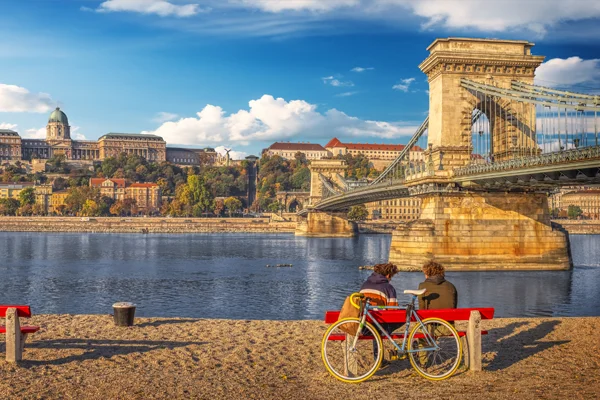Why Visit Budapest?
Budapest is a city of contrasts and harmonies.

Budapest, the capital of Hungary, is one of Europe’s most enchanting cities, blending a rich historical legacy with a vibrant contemporary culture.
Straddling the majestic Danube River, the city is divided into two parts: Buda, with its rolling hills and historical sites, and Pest, the dynamic, flat urban hub brimming with art, nightlife, and commerce. Together, they form a metropolis that is both grand and intimate, steeped in history yet pulsating with modern energy.
Historical Overview
Ancient Roots and Roman Influence
The area now known as Budapest has been inhabited since prehistoric times. It was a key location in the Roman Empire, known as Aquincum, the capital of the province of Pannonia. Ruins of Roman baths, amphitheaters, and villas can still be visited today, offering a glimpse into the city’s ancient past.
Medieval Glory and Ottoman Rule
By the Middle Ages, Buda emerged as a royal residence under Hungarian kings. The Mongol invasion of 1241-42 devastated the area, but it quickly rebounded. The 16th century brought a long period of Ottoman occupation, lasting over 150 years, which left behind a legacy of Turkish baths and architectural influences.
Habsburg Era and the Austro-Hungarian Empire
After the Ottomans were expelled, Hungary came under Habsburg rule. The 19th century was a period of rapid development, especially following the Austro-Hungarian Compromise of 1867, which created the dual monarchy. Budapest became one of the co-capitals of the empire, undergoing a transformation into a grand European city.
20th Century Turmoil
The 20th century saw Budapest caught in the crossfires of World War I, World War II, and a brutal communist dictatorship. The 1956 Hungarian Uprising against Soviet control is a key moment in modern Hungarian history. Democratic reforms in 1989 led to a rebirth of the city, which now thrives as a cosmopolitan European capital.
Cultural and Architectural Heritage
Landmarks and Architecture
Budapest’s architectural diversity is staggering. From Gothic churches to Neoclassical public buildings and Art Nouveau facades, the city is a living museum.
- Buda Castle: Perched atop Castle Hill, it houses the Hungarian National Gallery and the Budapest History Museum.
- Parliament Building: A neo-Gothic masterpiece on the banks of the Danube, it’s one of the largest and most impressive legislative buildings in the world.
- Fisherman’s Bastion: Offering panoramic views of the city, this fairytale-like terrace is a favorite among photographers.
- St. Stephen’s Basilica: Named after Hungary’s first king, this Roman Catholic basilica features breathtaking interior design and a dome with sweeping city views.
Thermal Baths
Budapest is famed for its thermal baths, a legacy of both Roman and Turkish times. Iconic bathhouses include:
- Széchenyi Thermal Bath: One of Europe’s largest spa complexes, known for its outdoor pools.
- Gellért Baths: A stunning Art Nouveau bathhouse within the Gellért Hotel.
- Rudas Baths: Dating back to the 16th century, this Turkish-style bath blends old and new.
Culinary Delights
Hungarian cuisine is hearty, flavorful, and deeply rooted in the nation’s traditions.
- Gulyás (Goulash): A rich stew made with beef, vegetables, and paprika.
- Lángos: Deep-fried dough topped with sour cream and cheese, popular street food.
- Paprikás Csirke (Chicken Paprikash): Chicken cooked in a creamy paprika sauce.
- Dobos Torte and Kürtőskalács (Chimney Cake): Traditional Hungarian desserts enjoyed by locals and tourists alike.
Budapest’s culinary scene has also embraced modern gastronomy. The city now boasts a growing number of Michelin-starred restaurants, wine bars, and international eateries.
Modern Culture and Nightlife of Budapest
Budapest’s cultural scene is eclectic and dynamic.
- Museums and Galleries: The Hungarian National Museum, the Museum of Fine Arts, and the Ludwig Museum of Contemporary Art are must-visits.
- Theatre and Opera: The Hungarian State Opera House is renowned for its stunning architecture and world-class performances.
- Ruin Bars: Unique to Budapest, these are eclectic bars built into abandoned buildings, filled with mismatched furniture, street art, and bohemian charm. Szimpla Kert is the most famous.
The city's Sziget Festival, Budapest Spring Festival, and the Budapest International Documentary Festival—draw international crowds and highlight its role as a cultural capital.
Tourism and Travel
Budapest has a well-developed public transport system, including buses, trams, trolleybuses, and a metro (the oldest in continental Europe). The Budapest Card offers tourists unlimited travel and free or discounted entry to many attractions.
The surrounding countryside is dotted with charming towns and historic sites:
- Szentendre: A riverside town known for its art galleries and Mediterranean ambiance.
- Visegrád: Famous for its medieval citadel and panoramic views of the Danube Bend.
- Eger: Renowned for its castle, thermal baths, and Bull’s Blood wine.
Several parts of Budapest are UNESCO-listed, including the Banks of the Danube, the Buda Castle Quarter, and Andrássy Avenue.
Living in Budapest
Budapest is increasingly popular among expats, digital nomads, and students, thanks to its high quality of life and relatively low cost of living compared to Western European capitals. The city offers excellent healthcare, diverse international schools, and a thriving tech/startup ecosystem.



